A Process for Preparing Glass Molds

| Crystallograph, A Process for Preparing Glass Molds |
 |
| As we learned from the Lesson on other
methods of colorless decor, most EAPG was fancy because of the decoration
left
from the mold -
that is - the design was formed on the surface of the pieces because the
mold was cut to reflect a design. When the mold was filled with molten
glass, the resultant product was irregular on the surface from the start.
The design so formed is what we call the pattern. This lesson is all about an early, rather obscure process that not even the originator of the technique named.... at least that we know of. It is called "Crystalloid" in catalogs, "Crystallograph" in early publications and we are sticking with "Crystallography" which is what most latter day glassies seem to prefer. You can call it whatever you want to. |
Following are excerpts
from Earl Autenreith's articles about this process, used by permission. |
| Certain unusual
patterns of EAPG are intriguing, not
because the actual pattern itself is so unusual, but rather because of
the way
the
pattern appears. On some pieces with this decor, the figures are
depressed below the surface of the glass
but on most pieces the design is raised off the glass surface. This unique
process has the distinction of being the world's most difficult glass
to photograph
(personal observation) and will lead us to learn about this method of
preparation of the mold. On the right is an example of crystallography decor on a mug with an owl and some branches. |
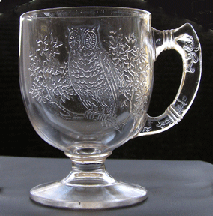 |
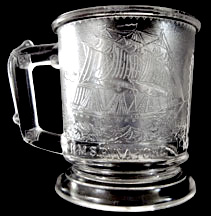 |
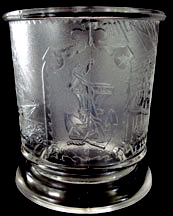 |
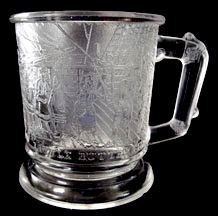 |
| Above is a rare mug created in 1879 for the 1878 H.M.S. Pinafore musical by Gilbert and Sullivan. It is for sale in our Mug Store. | ||
| Crystallography is a process of preparing
glass molds developed by Henry Feurhake, a printer and lithographer in Pittsburgh,
Pennsylvania.
Patent
No. 219.245 was granted to him on September 2, 1879, describing the process
as follows. --First the design is printed on paper, "the ink being applied when a lithograph stone is used by a composition roller and the stone kept dry." --Second, the design is transferred to the surface of the mold to be etched. --Third, the application of an acid resisting powder increases the density of the transferred ink. --Finally the acid is applied to the unprotected surface of the mold to "etch the mold." The resulting glass pressed from this mold has a granular surface with clear, intaglio figures forming the design. This process must have been a difficult one since the use of it seems to have been short-lived. Because the patent was granted to Feurhake and assigned to Washington Beck, a well-known mold maker in Pittsburgh, it is presumed that Feurhake and Beck made the known molds for crystallography designs. |
| The Dithridge Fort Pitt
Glass Works issued a catalogue (printed by "Armor, Feurhake & Co.,
Ltd. Lith. Pittb") in January 1880** offering "Crystalloid
Glass Ware." See at Right This catalogue page shows a limited production of crystalloid glassware: a number of pieces in a pattern they called Stork (or some now call Blue Heron - Kamm 4 pg 24) are illustrated as well as an unnamed pattern covered marmalade jar showing an elk. That goblet is known today as Flying Stork. |
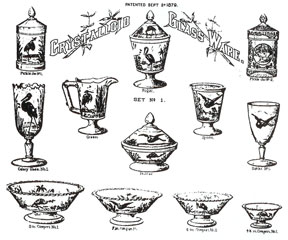 |
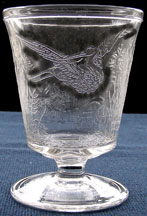 |
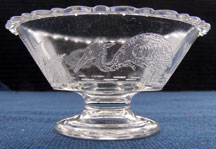 |
| Above are pictured two pieces
shown in that Ft. Pitt Glass Works Catalog On the left is the spooner in the pattern we now call Blue Heron & on the right is a footed sauce dish in the same pattern. |
|
| Another page from a Ft. Pitt Glass Works
catalog shows a goblet
decorated
with
an owl
surrounded
by what
appears to be a horseshoe (seen below). The catalogue pictures
and lists prices for two mugs. Also shown in the catalog are a Stork covered high standard compote and water pitcher and a covered compote in the unnamed Elk pattern. A lace-patterned cheese plate & a bread plate also appear in the price list. Other pieces in the pictured patterns may exist. |
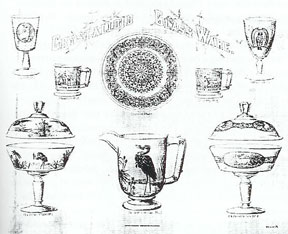 |
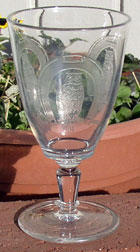 |
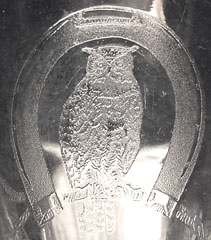 |
| Here is
the above mentioned (extremely difficult to photograph) goblet known today as Ta Dah...... Owl in Horseshoe! |
|
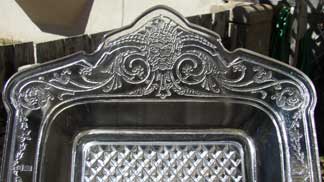 |
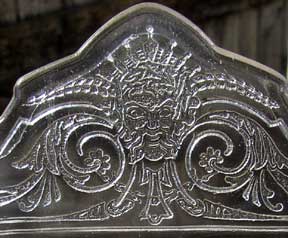 |
| The bread plate that might have been referenced in the price list with this decor might be this one called Aoelis (which see in our Bread Plate Store). Another possibility could be the one called Cupid or Virginia Dare by various folks. | |
| According to the American Pottery and
Glassware Reporter for October 2, 1879, " Washington Beck has just got out molds for three additional pieces of ware in the crystallograph series now being made by the Dithridge & Co. of the Fort Pitt Glass Works... [The three additional molds] ...include a mug to match 'Little Bo-Peep,' to be known as "Little Buttercup" and having scenes from the familiar 'Pinafore' on it; the others are for six such comports, one of vine pattern, the others having a boy, chickens, houses, etc." |
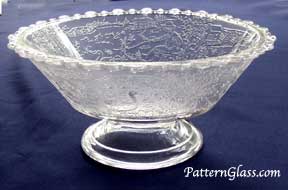 |
| We believe we have finally found an example of the bowl referred to at left! It is about 6" diameter at the top. See close-up photos below of the boy fishing on left & chickens on right. |
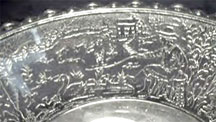 |
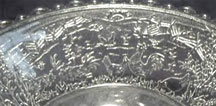 |
More from the American Pottery & Glassware Reporter, " Mr. Henry Feurhake, late of Armor, Feurhake & Co., is the designer for the new factory... Five pressers are now in use, all built by Washington Beck... The molds are from the same establishment. They include a fine line of the new crystallograph series, patented lately by Messrs. Beck and Feurhake... Since then the patterns have been wonderfully improved and still further changes for the better are contemplated... It is the purpose of the management to make a full line of tableware, bar goods, etc. with crystallograph as a specialty. In the latter they are making a beer mug of a very handsome pattern, uniquely decorated." (See Becky's photo) This type of glass is the product only
of Dithridge & Co.
(Fort Pitt Glass Works) for early known patterns, or Riverside Glass
Works for some designs. Feurhake Beck, as owners of the patent would
likely have taken molds, used at Fort Pitt, with them to Riverside. |
| The process, for whatever reason - difficulty
with working or cleaning the molds, or lack of popularity of the designs
- appears to have been short-lived. Any pieces found would have to be considered rare." Further research may discover other patterns. Be on the lookout! |
PatternGlass.com
is grateful for and indebted to Earl Autenreith, Kat Krivda and Becky Lyle for providing the information for this Lesson. ** Fort Pitt Glass Works Catalogue, January, 1880 Courtesy of Kirk Nelson, Curator of Glass at the Sandwich Museum |
 |
 |
 |